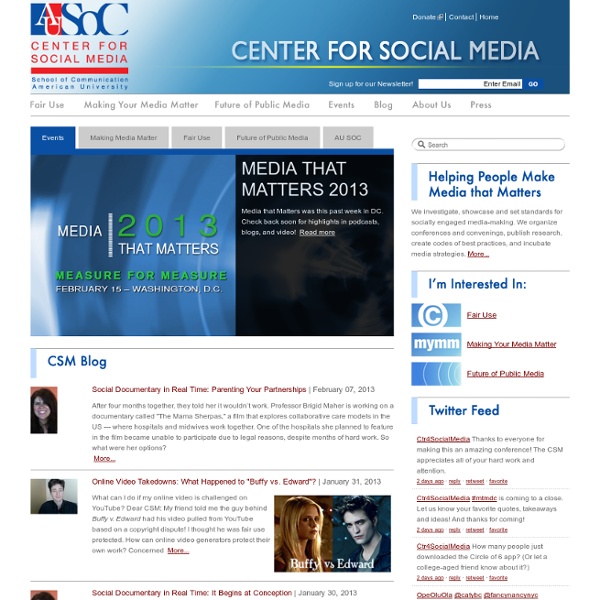



http://www.centerforsocialmedia.org/
Related: Copyrights and Wrongs and Fair Use • CopyrightPublic Domain Collections: Free to Share & Reuse That means everyone has the freedom to enjoy and reuse these materials in almost limitless ways. The Library now makes it possible to download such items in the highest resolution available directly from the Digital Collections website. Search Digital Collections No permission required. Don't Sell Your CDs & DVDs! 5 Downsides to Going Digital Advertisement The world is shifting into digital gear at a rapid pace and everyone is racing to stay ahead. Video games, eBooks, music, movies, and TV shows. After 10 Years, Google Books Is Legal On Friday, a federal circuit court made clear that Google Books is legal. A three-judge panel on the Second Circuit ruled decisively for the software giant against the Authors Guild, a professional group of published writers which had alleged Google’s scanning of library books and displaying of free “snippets” online violated its members’s copyright. To some digital-rights followers, the Google Books case had seemed to drag on forever: The Authors Guild first filed suit 10 years ago. But the theory behind the eventual ruling was a quarter-century in the making.
Copyright Flowchart: Can I Use It? Yes? No? If This… Then… It is the responsibility of all educators to model good digital citizenship for their students. Especially when it comes to copyright, plagiarism and intellectual property. The waters are murky. Not being familiar with online digital rights and responsibilities (hey, teachers did not grow up with the Internet being around), educators are wading through uncharted waters (hey, I did not know that I could not just google an image to use. If someone puts it up online it is free for the taking). That does not mean they can close their eyes and pretend life is the same or that the same rules apply to online versus offline use of copyrighted material with their students.
Teaching Copyright As today's tech-savvy teens become increasingly involved with technology and the Internet for learning, work, civic engagement, and entertainment, it is vital to ensure that they understand their legal rights and responsibilities under copyright law and also how the law affects creativity and innovation. This curriculum is designed to give teachers a comprehensive set of tools to educate students about copyright while incorporating activities that exercise a variety of learning skills. Lesson topics include: the history of copyright law; the relationship between copyright and innovation; fair use and its relationship to remix culture; peer-to-peer file sharing; and the interests of the stakeholders that ultimately affect how copyright is interpreted by copyright owners, consumers, courts, lawmakers, and technology innovators. Unit Goals Educate students about copyright law, including the concepts of fair use, free speech, and the public domain.
Citing an Image is Not Enough! I am thrilled to see so many students creating blog posts and going BEYOND “writing” text made up letters, words, sentences and paragraphs. Being able to “read” and “write” in other media is part of becoming fluent in media literacy. In addition to media literacy, knowing your rights and responsibilities as an ethical digital citizen is a vital part of participating in our digital world. My frustration with educators not knowing about observing copyright when producing content online was expressed in a previous post titled No! You Can’t Just Take It!. The Educator's Guide to Copyright and Fair Use A five-part series When it comes to copyright law and the application of fair use exceptions, ignorance is definitely not bliss! Learn how to educate yourselves and your students and avoid making a costly mistake! You really did plan to find time over the summer to familiarize yourself with the latest information on copyright law. You absolutely intended to look up the fair use guidelines for using technology resources.
Silvia Tolisano- Langwitches Blog When using Copyrighted work with written permission from owner… Used with permission from “name” , URL link to original source and or owner online presence. Ex. Copyright and Primary Sources How do I use the Restriction Statements that accompany the American Memory collections? The Library of Congress assesses materials for legal considerations prior to placing items online (see legal assessment). The Restriction Statement that accompanies each American Memory collection provides known information regarding ownership of materials in the collection. Fair Use in Visual Arts: You Be the Judge Artists, publishers, scholars and curators depend upon fair use in the Visual Arts more than they realize. The Code of Best Practices in Fair Use for the Visual Arts was created by professionals from different fields within the Visual Arts to unified and express their interpretation of fair use. Here are examples of uses of copyright material in the Visual Arts. Test your skill and use the Principles to draw your conclusions. Then check your answers at the bottom. The Academic Illustration
Taking the Mystery Out of Copyright skip navigation Library of Congress Teachers Suggestions enabled. The Library of Congress > Teachers > Classroom Materials > Presentations and Activities > Copyright Print Subscribe Share/Save Give Feedback Strategies for Fair Use Summary: This resource provides a few general strategies about how to use fair use policies and copyright laws. Anyone dealing with a specific legal issue or dilemma should contact a lawyer. Download & Streaming : Moving Image Archive movies eye favorite 2 comment 0 Compfight Safe Images Plugin – Edublogs Help and Support The Compfight Safe Images plugin is a quick and easy tool to quickly find, add and add proper attribution for Creative Commons images to your posts. Below is an example of an image inserted using Compfight Safe plugin: Photo Credit: Alexey Kljatov via Compfight
An excellent resource for utilizing Fair Use and how it relates to copyright when creating and sharing materials in an academic setting! by patricewheeler Apr 24